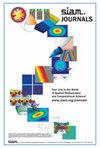合成孔径雷达的过渡球自动对焦
IF 2.3
3区 数学
Q3 COMPUTER SCIENCE, ARTIFICIAL INTELLIGENCE
引用次数: 0
摘要
SIAM影像科学杂志,第16卷,第4期,2144-2174页,2023年12月。摘要。地球电离层电子数密度的湍流波动会影响星载合成孔径雷达(SAR)的性能。以前,我们已经量化了过渡层SAR图像可能退化的程度,因为它取决于电离层的状态和SAR仪器的参数。然而,没有人试图减轻电离层湍流的不利影响。在当前的工作中,我们提出了一种新的基于优化的自动对焦算法,该算法有助于纠正星载SAR图像的湍流畸变。与文献中可用的传统自动对焦程序不同,新算法允许SAR信号的相位扰动不仅依赖于慢时间,而且依赖于目标坐标。这种依赖性是分析由于湍流引起的图像畸变的核心,但在传统自动对焦的情况下,由于天线位置的不确定性导致的畸变是不存在的。本文章由计算机程序翻译,如有差异,请以英文原文为准。
Transionospheric Autofocus for Synthetic Aperture Radar
SIAM Journal on Imaging Sciences, Volume 16, Issue 4, Page 2144-2174, December 2023.
Abstract. Turbulent fluctuations of the electron number density in the Earth’s ionosphere may hamper the performance of spaceborne synthetic aperture radar (SAR). Previously, we have quantified the extent of the possible degradation of transionospheric SAR images as it depends on the state of the ionosphere and parameters of the SAR instrument. Yet no attempt has been made to mitigate the adverse effect of the ionospheric turbulence. In the current work, we propose a new optimization-based autofocus algorithm that helps correct the turbulence-induced distortions of spaceborne SAR images. Unlike the traditional autofocus procedures available in the literature, the new algorithm allows for the dependence of the phase perturbations of SAR signals not only on slow time but also on the target coordinates. This dependence is central for the analysis of image distortions due to turbulence, but in the case of traditional autofocus where the distortions are due to uncertainties in the antenna position, it is not present.
Abstract. Turbulent fluctuations of the electron number density in the Earth’s ionosphere may hamper the performance of spaceborne synthetic aperture radar (SAR). Previously, we have quantified the extent of the possible degradation of transionospheric SAR images as it depends on the state of the ionosphere and parameters of the SAR instrument. Yet no attempt has been made to mitigate the adverse effect of the ionospheric turbulence. In the current work, we propose a new optimization-based autofocus algorithm that helps correct the turbulence-induced distortions of spaceborne SAR images. Unlike the traditional autofocus procedures available in the literature, the new algorithm allows for the dependence of the phase perturbations of SAR signals not only on slow time but also on the target coordinates. This dependence is central for the analysis of image distortions due to turbulence, but in the case of traditional autofocus where the distortions are due to uncertainties in the antenna position, it is not present.
求助全文
通过发布文献求助,成功后即可免费获取论文全文。
去求助
来源期刊

SIAM Journal on Imaging Sciences
COMPUTER SCIENCE, ARTIFICIAL INTELLIGENCE-COMPUTER SCIENCE, SOFTWARE ENGINEERING
CiteScore
3.80
自引率
4.80%
发文量
58
审稿时长
>12 weeks
期刊介绍:
SIAM Journal on Imaging Sciences (SIIMS) covers all areas of imaging sciences, broadly interpreted. It includes image formation, image processing, image analysis, image interpretation and understanding, imaging-related machine learning, and inverse problems in imaging; leading to applications to diverse areas in science, medicine, engineering, and other fields. The journal’s scope is meant to be broad enough to include areas now organized under the terms image processing, image analysis, computer graphics, computer vision, visual machine learning, and visualization. Formal approaches, at the level of mathematics and/or computations, as well as state-of-the-art practical results, are expected from manuscripts published in SIIMS. SIIMS is mathematically and computationally based, and offers a unique forum to highlight the commonality of methodology, models, and algorithms among diverse application areas of imaging sciences. SIIMS provides a broad authoritative source for fundamental results in imaging sciences, with a unique combination of mathematics and applications.
SIIMS covers a broad range of areas, including but not limited to image formation, image processing, image analysis, computer graphics, computer vision, visualization, image understanding, pattern analysis, machine intelligence, remote sensing, geoscience, signal processing, medical and biomedical imaging, and seismic imaging. The fundamental mathematical theories addressing imaging problems covered by SIIMS include, but are not limited to, harmonic analysis, partial differential equations, differential geometry, numerical analysis, information theory, learning, optimization, statistics, and probability. Research papers that innovate both in the fundamentals and in the applications are especially welcome. SIIMS focuses on conceptually new ideas, methods, and fundamentals as applied to all aspects of imaging sciences.
 求助内容:
求助内容: 应助结果提醒方式:
应助结果提醒方式:


